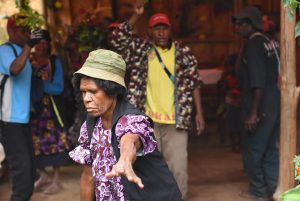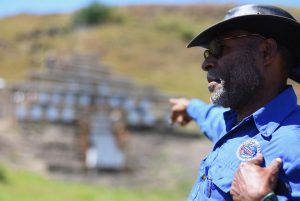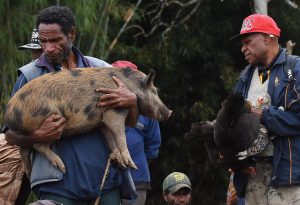If you would like more than 8 samples, please contact a trader directly.
Cart
A trader will contact you with shipping and payment options after checkout. Please note: free samples are provided to commercial roasting businesses only.
Ben Heins in PNG, August 2018
It was this cowboy’s first rodeo in PNG, but Crop to Cup’s fourth year with the AAAK Cooperative. So, I had an idea of what was going on. Trip prep included conversations with the charismatic cooperative head, Brian, as we all worked to encourage the first ever cupping competition between the farmer “clusters.” For review, AAAK comprises Apo, Angra, Angana and Kange Cooperatives (with the addition of Angana, the name recently changed from AAK). These coops span the three coffee producing provinces in Papua New Guinea; Eastern Highlands, Western Highlands and Chimbu/Simbu. Different places, different languages, different cultures with one thing in common. Coffee.
Due to a history of differences, the cooperative’s message has all along been one of unity. Brotherhood in coffee. Which is what makes the idea of a cupping competition so different.
But elders in the coop have reason to try something new. Kids are running off to the cities (Goroka, Port Moresby, Lae, Hagen) in hopes of cosmopolitan careers. Not many find it, and the farms are drained of talented young minds that could have otherwise focused on the business of agriculture. That’s what prompted Brian Kuglame, a farmer from Simbu province himself, to form AAK in 2000, to encourage self-reliance in his and surrounding communities. Eighteen years later, I’m here to survey the results.
I can pay Brian an awkward compliment (my specialty). At the outset he was so energetic, wide-eyed, insistent and passionate that it came off as slightly saccharine. He talks like his mouth just can’t keep up with the enthusiasm of his mind. And all that he had to say was just too hard to believe.
AAAK is now 62 active clusters. Many clusters require flying into a remote air-strips, which is perhaps a godsend if the road from Goroka to Kundiawa is any good representation of the general state of infrastructure (and I think it is). To be sure, he leans on the AAAK management (Apo – Warren, Angra – Jerry, Angana – Kombuk, Kange – Stanley) to help motivate his clusters and organize action and activity. That said, Brian still plays Atlas. He travels 5 days a week, flying many of those days. His moves are graceful, forceful and calculated. To give you an idea of his foresight – I have to talk about Brian’s bag – called a bilum.

A bilum bag. In PNG they sell them in stores and you’ll see them on the roadside as well. A cultural institution to be sure. But Brian, he has his own bilum. This thing is the Amazing Dream colored coat of bilums. White with multicolored tassels, emblazoned with the AAK logo and prominently displaying the name of each constituent coop in its respective color. After a welcome with sing sing outfits and dancing, there was a cascade of greetings from top management all the way down to Taylor, our roaster guests and myself. Then Brian. When his turn comes Brian steps on stage, pulls out the bilum and begins speaking to the audience in the local pidgin. Not understanding a word, I did follow the tone as it started out enthusiasticly, then built into a crescendo of pride approaching reproach, sounding like anger. He holds the bilum up to the crowd, unzips it, and pulls out….
A bilum tied inside the original bilum. Without context, I have to say, this is all very comical. I mean – this bilum is so ornate it was like the Ark of the Covenant…and then, after all the build-up, when what came out was another bilum – I almost spit out my water. But Brian, ever the savvy leader and cunning educator, was using the bilum to make a point.
The inner bilum said, ANGANA. There were 3 more bilums – APO, ANGRA and KANGE. These are the names of the 4 sub-cooperatives, each meaning ‘brother’ in the local language. The outer bilum represents AAAK cooperative, but it was also the mother, showing how all of the sub-cooperatives are actual brothers. The cluster groups, Brian explained, are the children – and the children are what everyone is working for.
The structure is important because Brian is pushing this year to overhaul the pricing transparency system. He calls it a new docketing system. It means farmers are registered and payments to AAAK will be reported out and transparent. (not that there isn’t honest accounting happening, but it’s an old paper receipt system and hard to unravel the dollars in a way that is easy to comprehend).
This merit-based payment, on top of the cupping competition, could be a cause for strain as well as an opportunity for engagement. And so we saw Brian pull out his bilum of many colors at every gathering – reinforcing their connection to AAAK, the strength in solidarity and folly in falling out. Not a rookie move for a man that’s battling poaching from other exporters and apathetic farmers within his group. When you look into the audience while he talks, you see head nods, grunting in approval, smiles – all a part of his gentle massage of compliments, reassurances, appeals for patience and diligence, and at last his challenge. Do this for your kids. We’re all doing this for the next generation.
This is the challenge of smallholder coffee. And this is execution at its best.
Of our visits, our very first was to Kesevaka Base Camp. And it is one worth first mention.
I laugh just thinking about it, because it started with a few uneasy white guys standing on a dirt road. Brian has a loudspeaker on the AAK Landrover – and to let Kesevaka know of our arrival he hits an overhead button in rapid succession. Goose honks blurt out of the truck as we side-eye each other. Seemingly nothing happens next. We get out of the car and see a welcome banner across trees in the distance. We can hear a crowd. Far off. Not talking. With a low hum – like a hive – that is then suddenly punctuated by screams. Shrieks of terror, male and female.

Okay, Kesevaka – you have my attention. Just then, a somebody slaps the inside of my knee and quickly rides a hand up my inner thigh. It was a combustion of emotions; scared, mildly violated and maddeningly confused. I turned around and saw a betel-nut stained grin on a dancing old woman, who, was clearly over the damn moon that the car delivered us to her driveway. (We later learn that the leg shake is like a handshake for special greetings in this region.)
But before Kesevaka, we were taken to the Jucuru Training Center.
The training center broke ground in the last 18 months and is on track to be completed in a few more. Youth engagement is the goal. I touched on the problem earlier. This is the AAAK response. Upon arrival you’ll see hundreds of bee hives (arranged in a hive structure that is designed to look like the tree-shape of the AAAK logo – photo above). You’ll see a fish pond to teach fish farming, a piggery and livestock training area. You’ll see fruit trees and gardens, a demo coffee plot, a newly built tool shed, and a model home. Space has been staked out for the 3,000 sq ft training center building, and a large campsite to host up to a hundred youth at a time.

If you go you’ll see a banner where Brian has put four steps to follow….or rules to live by …. or goals to aim for, depending on how you look at it.
Once complete the Jucuru training center will bus in youth who will camp on the premises. Kids will learn all the skills necessary to have a diversified agricultural business on the home front. Grow your own food, plant 2000 coffee trees for income. AAAK will provide a set of hives and queen bees for any farmer with 2000 trees so that they have additional revenue through honey. Now breeding pairs of pigs and chickens are on the center. As they reproduce livestock will also be given to farmers, so they can start to build wealth through animal husbandry. Maybe I’m just looking through at twenty years of dedication with fresh eyes – but it was overwhelming. A clear vision, a tactical path, a charismatic leader. All the ingredients. And us. I have to tip my hat to my man Jake – Brian credited him with the idea of focusing on youth. Jake – you lit some sort of fire under that man – because he’s on it.
The week proceeds with multiple base camp visits. But the many beautiful welcomes and grandstanding couldn’t overshadow other good news on the coffee front. Quality is up.
The AAAK staff are well trained from CIC (PNG Governmental coffee support org – where Brian in fact worked), and with better prices and consistent purchases from Crop to Cup, have invested in the next steps toward quality, mainly centralized wet mills and drying. Both Kesevaka and Kogai have wet mills in various stages of completion. Brian thinks that taking in more cherry will help the consistency of coffees. I tend to agree – and when I asked Simon of Apo Coop about some construction details, he was on top of it.
Ben: With this new mill you’re going to need a lot more drying capacity
Simon: Yes. We have already begun working on the raised mats for drying
Ben: What are you going to use for the new drying area? Perhaps you look for the shadiest side of the hill.
Simon: Of course. We selected this site for just that reason.
These conversations were par for the course on most processing investigation. Same went for other ag practices. They have AAK nurseries, and are mainly replanting Blue Mountain (Typica) and some Bourbon . No complaints here.
Rust and old trees are bugaboos – but Brian suggests that these are just symptoms of farmer apathy. Easily resolved with a re-invigorated community. Again – I don’t disagree. I also should say – I don’t think I’ve been anywhere else where our presence has meant so much. The pride that the farmers have in hosting visitors, and moreso, knowing that their community’s name gets to the States on a coffee bag – it’s frenetic. Which is to say, from Brian’s point of view, the purpose of our visit was to help invigorate, and we did our best indeed.

Which brings me to our final day in, Waingar. This is the day we reveal the winners of the cupping competition.
It’s no exaggeration, hundreds of people attended. Brian worked all night erecting the stage, decorating the area, preparing gifts (sweet potatoes) for all AAAK members that attended. He also has a couple additional guests, a speaker from the Simbu county Ag Board (who we picked up ad-hoc along the way — remember how strategic I think Brian is?) and a representative from Care International and the savings bank project that will open accounts with Waingar farmers right onsite at the end of the event. Part of Brian’s new docketing system is direct payments into farmers’ bank accounts, with some automatically going to a separate savings. Again, a nod to the thoroughness of the vision and exacting execution and follow-through.
It’s the day of the event, and I’m thinking through what I’m going to say. I consider a redo of a joke that bombed during my opening speech in Kesevaka – I resist. We begin with a beautiful sing-sing welcome where we’re all escorted via locked hands, with fully decorated young women of Waingar, for what seems like a sweaty-palmed awkward eternity for us all, I’m sure.
Personally, I can’t wait. For two reasons. First, I’m genuinely excited. And more importantly, I’ve been promised that Taylor gets to personally hand-off the sow and bull pigs that will be awarded as second prize. And as you see above, the local reporter that traveled with us chose that EXACT photo for print!.
These prize pigs, we saw later, were donated back to AAAK’s training center to begin their first piggery!Literally returning the prize pig to AAAK so they can begin the breeding center
The awards are emotional in PNG. Farmers literally just start howling with pride. The Kopio chairman was carried to the stage. It was real. This wasn’t another coop meeting. This was a celebration, with delegates from the USA. This was a stepping stone back to self-reliance. Brian said, “You see. We told you that they would come, we told you they would buy, they are here. Now you see,”
This was the start of a road that the next generation can walk confidently – expecting that as they invest, as they resist the call of that city life, that their sweat will be rewarded with a dignified life that allows them to surely provide for their families, and slowly improve their economic position.
Today – I write this after a walk on the beach in East New Britain. Tiny town of Kokopo, which is the city center after the volcano in Rabual destroyed the old downtown. As you walk off the hotel beach you get to the local beach, filled with banana boats and their betel nut chewing owners – waiting around to take goods and passengers across to the Duke of York islands a few miles off the coast. At the end of the beach, I run into a few young folks with curious smiles on their faces. University kids – studying education – having a few beers on a Friday. We get to chatting. After they get done explaining that they like Americans because they really can’t understand a lick of English from Aussies or Kiwis, I find out that two of them are from the Western Highlands. They grew up in Mt. Hagen – an hour or so from our awards ceremony in Waingar. They know the AAAK coop. Their families are farmers.
Ben “Everyone says the young folks aren’t staying on the farm, they come to the cities for jobs”
Sam: “Yes, that’s true. But most don’t find any good work”
Ben “Brian says that farmers can make good money if they work hard on the farm, and have many incomes from agriculture. Is that true? Can you make good money if you stay”
Sam: It’s true! The farmers are rich! Really.
Damned if Brian ain’t right. His leadership, vision and work ethic are flooring. If you’ve had anything to do with this coffee – I hope you get goosebumps. This is a real one.